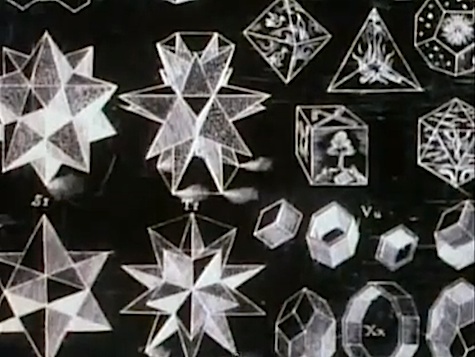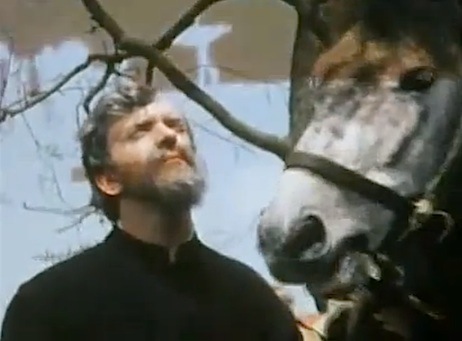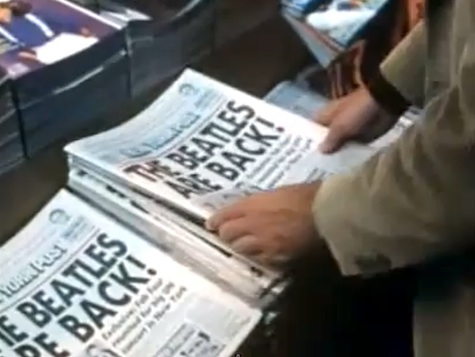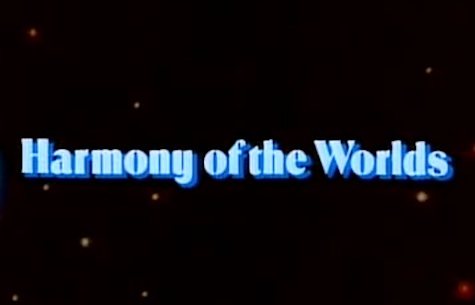The third episode of Cosmos, “The Harmony of the Worlds,” is a historically-oriented exploration of the development of astronomy—as opposed to astrology. It is also implicitly concerned with the complex interplay between fantastical thinking and observational or theoretical science in human culture. The basic proposition that guides the episode is simply, “There are two ways to view the stars: as they really are and as we might wish them to be.”
The idea of what “really is” and what is merely a “wish” here becomes complicated, intriguing. The episode is on the surface concerned with astronomical development up through Johannes Kepler, but Sagan works in a great deal of commentary on the nature of belief and belief’s problematic relationship to science. The subaltern concern of “The Harmony of the Worlds” is not astronomy, but the act of doing science as opposed to the act of belief—though Sagan also complicates that functional relationship in his narrative of Kelper’s life.
The complex rhetorical spirals of “One Voice in the Cosmic Fugue” have straightened out into a much more linear narrative, here. However, there is a subordinate story working its way through the episode (an argument about religion and belief) that runs consistent and corollary to the main narrative. If I had to draw a sketch of this episode’s structure, it would be one solid line with a wavy, dash-y line underneath, hovering in its shadow, that bursts suddenly into the bold solid of the upper line at the very end in a consummation of history and theory.
But, we begin with astrology, which Sagan introduces as an old system of meaning-making that we used before we had a proper understanding of what was happening in the sky—and that somehow has hung around, despite how thoroughly it’s been disproven. He is not gentle with astrology; it’s worth noting, and remembering, that this sharp analysis is where the episode begins. Astrology, he says, is “fuzzy thinking and pious fraud” that “pretends to satisfy our longing to feel personally connected with the universe” but results in “a dangerous fatalism.”
Then he appeals to the scale of the universe, with stars that are suns numbering in the billions, and asks: how did we discover the other stars, the planets, and how they work? In this way, he moves from that pious fraud of mystical belief to the observational science of space, a.k.a. astronomy, and that’s where we spend the majority of the episode. Once Sagan has established the science of astronomy against the theism of astrology, he guides us into a history of “thinking men and women who preceded us” in theorizing the cosmos. (I appreciate that he begins with the Anasazi, and also notes women in particular; Sagan’s efforts toward inclusiveness are still soothing decades later.) He rolls through a history of how we have tried to answer the question “what makes it all go?” – from Ptolemy to Copernicus to the star of the latter half of the episode, Johannes Kepler.

Kepler’s life and work form the narrative for the rest of the episode, while his search for harmony and the hand of god in the math of the universe provides the title. This is an almost allegorical story—it is full of facts and fascinating discoveries about the planets, stars, and Earth, but it also models and problematizes those issues of faith and science that began the episode. Kepler’s persecution and his struggles to embrace a faith that led him into science, despite the aggression of the organized church, provide a counterbalance to what might otherwise be a purely negative argument about faith. While the church does distinct evil through religious extremism and fanaticism, Sagan also makes clear that the search for a spiritual narrative of god is what drove Kepler’s scientific exploration.
To close, Sagan discusses Kepler’s science fiction writing while juxtaposing shots of the actor playing Kepler with footage of man on the moon and the space probes. The idea of harmony and faith comes back in, balanced gently—Sagan says, “Harmony in this world eluded [Kepler],” but his three laws “represent a real harmony.” From Kepler’s work, we’ve discovered scientific laws and found “a resonance, a harmony, between the way we think and the way the world works.”

Kepler, Sagan says with pleasure and seriousness alike in his voice, “accepted the uncomfortable facts; he preferred the hard truth to his dearest delusions. That is the heart of science.” And there we have come full circle from the contrast of faith and science to a way that they may exist together.
*
This episode, as I’ve noted, plays an interesting balance between condemnation of magical thinking/religion and joy in the discoveries that faith drove along, such as Kepler’s belief in god-the-mathematician. While I find astronomical history interesting, I find Sagan’s subtle, often-gentle, often-clever rebuttals of faith-oriented constructions of the cosmos to be much more so—how he chooses to formulate this argument, to convey it, and to render it palatable to a wider audience. Frankly, I find it a little thrilling to think about episodes like this one airing on the Public Broadcast System in 1980; I’d find it kind of thrilling today, too. Sagan avoids the potential pitfalls of what would become the New Atheist school of argument—generally, being a giant asshole—to make a substantive and convincing set of arguments about the place of faith and the place of science in our world.
In the same vein, this episode is also the source of one of my favorite Carl Sagan quotes: “The desire to be connected with the cosmos reflects a profound reality: we are connected, not in the trivial ways that the pseudoscience of astrology promises, but in the deepest ways.” He restates this idea variously in different episode (we are all made of “star stuff,” etc.), but this formulation is particularly powerful as it contrasts the fanciful delusions of mythology—and, implicitly, religious faith (note that Christianity is discussed in similar terms as astrology, except with more murder and torture)—with the difficult but rewarding, fulfilling truth of the observed universe we may know through scientific exploration.

I guess it’s become kind of obvious by episode three where I stand on the faith versus science question, huh? However, I do think that Sagan’s formulations of spirituality and the potential uses for faith in science give a lot more leeway than my own; that’s an interesting middle-ground to take, and much more difficult to discuss. His willingness to accept the positive results of faith for men like Kepler contrasts the harsher arguments about folks who allow faith to negate science. It’s a strange balance; I mean, in the same glowing narrative of Kelper’s love of god and geometry, Sagan described the Reformation as a time when the “human spirit [was] fettered and the mind chained” by religion.
This balance—between the potential for the individual’s spiritual development and needs, and the destructive capacity of organized religion—leaves a lot of angles for debate, in a fun way. (Especially since it’s running as the undercurrent of the episode, only present directly at the very opening and closing.)
Other than that religious debate stuff, the visuals in this episode also made an impression on me. For one, the special effects are simple but neat, and for another, it is the first time that actors have been used extensively in Cosmos to represent historical events, as opposed to the usual animations and illustrations. In the case of the special effects, there is a clever camera trick to make it appear as if there are two Carl Sagans on the screen when he poses a theoretical problem: if astrology were valid, how could twins have profoundly different fates? As the camera pans backward with Sagan’s voice continuing on the screen, we suddenly see him walk into the front of the scene again, delivering the speech directly. The impact is still strong, no matter how far we’ve come in special effects since then; it certainly makes me smile.

The actors portraying Kepler from childhood to old age also make more direct and personal connections between the viewers and the history being discussed—especially, oh very especially, the closing scenes. In them, Sagan speaks about how Kepler’s ideas have allowed us to get where we are today: “Before Kepler, astronomy had little connection with physical reality […] he was the first to combine a bold imagination with precise measurements, to step out into the cosmos. It changed everything.” As he speaks, a human footprint on the moon is juxtaposed with Kepler walking along a dirt track, alongside views of planetary exploration devices. I mention it twice because it’s just breathtaking.
Finally, the little aside about Kepler writing what might have been the first science fiction novel is, in a way, heart-warming. It’s not just that Sagan mentions it as a curiosity—he makes a direct connection between being able to imagine, and being able to do science: “This fusion of facts with dreams opened the way to the stars.” That’s an idea that we still delight in, within the SF community today: that our dreams might help, one day, lead us to the stars.
*
Join us next week for a discussion of episode 4, “Heaven and Hell.”
Lee Mandelo is a writer, critic, and editor whose primary fields of interest are speculative fiction and queer literature, especially when the two coincide. She can be found on Twitter or her website.










